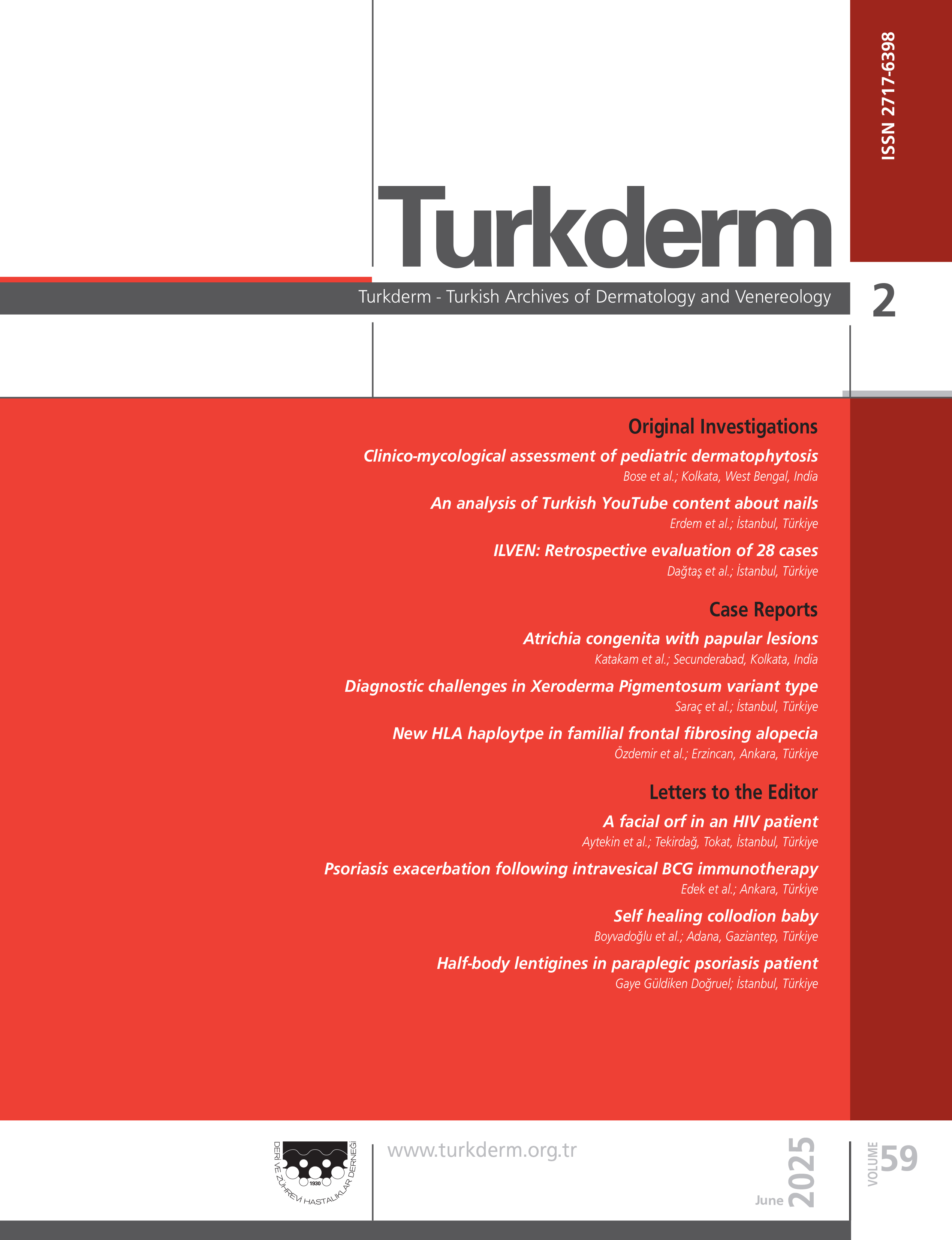The prevalence of verrucae among tradesmen who sell or cut meat at the city center of Isparta
İlkay İçke1, Pınar Yüksel Başak1, Reha Demirel2, Vahide Baysal Akkaya1Background and Design: The association of high prevalence of hand warts in butchers was first reported
more than 30 years ago and subsequent studies have supported this finding. We aimed to investigate the
prevalence of verrucae among the tradesmen who dealed with meat, fish and chicken meat in Isparta and to
compare them with groceries at the same sociocultural level who did not contact with meat.
Materials and Methods: A detailed questionnaire was applied to the study group consisting of tradesmen dealing
with meat and to the control group consisting of groceries, each of which have 155 individuals. Both of
the groups were examined whether they had verrucae on their hands or not.
Results: The rate of verruca vulgaris in the study and control groups were 17.4% and 6.0% respectively (p<0.001).
Verruca vulgaris was found to be significantly common among butchers compared with groceries (p<0.001).
Conclusion: Verruca vulgaris is frequently seen among people dealed with meat like butchers and this is an
important problem of public health because of the risk of contamination by direct contact. The results of our
study was compatible that the verruca vulgaris was more frequent in the meat industry workers in our region.
In our country, there are few published studies on this subject and this problem is still important regarding
public health. We believe that it is necessary to perform epidemiological studies in the related occupational
groups so as to inform about autoinoculation and contamination of verrucae.
Isparta İl Merkezinde Et Kesimi ve Satışı ile Uğraşanlarda Verruka Prevalansı
İlkay İçke1, Pınar Yüksel Başak1, Reha Demirel2, Vahide Baysal Akkaya11Süleyman Demirel Üniversitesi Tıp Fakültesi Deri ve Zührevi Hastalıklar Anabilim Dalı2Afyon Kocatepe Üniversitesi Tıp Fakültesi Halk Sağlığı Anabilim Dalı
Kasaplarda el verrukaları prevalansının yüksek olduğu 30 yıl kadar önce ilk kez rapor edilmiş, takip eden çalışmalar bu bulguyu desteklemiştir. Biz bu çalışmada Isparta il merkezinde tüm et ile (kırmızı et, balık, tavuk) uğraşanlarda verruka sıklığını araştırarak, iş yerinde et ile temas etmeyen benzer sosyokültürel düzeydeki bakkallarla karşılaştırmayı amaçladık.
Çalışmamızda et ile (kırmızı et, balık, tavuk) uğraşan çalışma grubu ile bakkallardan oluşan kontrol grubundaki 155er kişiye kapsamlı bir anket uygulanarak elleri verruka varlığı açısından muayene edildi.
Araştırma grubunda %17.4 oranında verruka saptanırken kontrol grubunda bu oran %6 idi (p<0.001). Kasaplarda bakkallara göre verruka sıklığı anlamlı olarak yüksek bulundu (p<0.001).
Verruka vulgaris kasaplar gibi et ile uğraşan kişilerde daha sık görülmekte olup direkt temas ile bulaşabildiği için önemli bir halk sağlığı sorunudur. Çalışmamızın sonuçları da yöremizde et ile uğraşan mesleklerde çalışanlarda verruka vulgarisin daha sık görüldüğünü ortaya koymuştur. Ülkemizde bu konuda az sayıda yayınlanmış çalışma mevcuttur ve sorun toplum sağlığı açısından güncelliğini korumaktadır. İlgili meslek gruplarında epidemiyolojik çalışmalar yapılarak verrukaların otoinokülasyon ve kontaminasyonu konusunda bilgilendirmenin önemli olduğu görüşündeyiz.
Manuscript Language: Turkish























